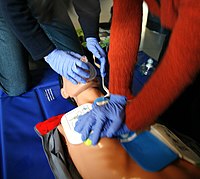
Photo from wikipedia
Rationale: Congenital heart disease can lead to life-threatening right ventricular (RV) heart failure. Results from clinical trials support expanding cardiac progenitor cell (CPC) based therapies. However, our recent data show… Click to show full abstract
Rationale: Congenital heart disease can lead to life-threatening right ventricular (RV) heart failure. Results from clinical trials support expanding cardiac progenitor cell (CPC) based therapies. However, our recent data show that CPCs lose function as they age, starting as early as 1 year. Objective: To determine whether the aggregation of child (1–5-year-old) CPCs into scaffold-free spheres can improve differentiation by enhancing Notch signaling, a known regulator of CPC fate. We hypothesized that aggregated (3-dimensional [3D]) CPCs will repair RV heart failure better than monolayer (2-dimensional [2D]) CPCs. Methods and Results: Spheres were produced with 1500 CPCs each using a microwell array. CPC aggregation significantly increased gene expression of Notch1 compared with 2D CPCs, accompanied by significant upregulation of cardiogenic transcription factors (GATA4, HAND1, MEF2C, NKX2.5, and TBX5) and endothelial markers (CD31, FLK1, FLT1, VWF). Blocking Notch receptor activation with the &ggr;-secretase inhibitor DAPT (N-[N-(3,5-difluorophenacetyl)-L-alanyl]-S-phenylglycine t-butyl ester) diminished these effects. To evaluate the therapeutic improvements of CPC aggregation, RV heart failure was induced in athymic rats by pulmonary artery banding, and cells were implanted into the RV free wall. Echocardiographic measurements 28 days postimplantation showed significantly improved RV function with 3D compared with 2D CPCs. Tracking implanted CPCs via DiR (1,1’-dioctadecyl-3,3,3’,3’-tetramethylindotricarbocyanine iodide)-labeling showed improved retention of 3D CPCs. Transducing 3D CPCs with Notch1-shRNA (short hairpin RNA) did not reduce retention, but significantly reduced RV functional improvements. Histological analyses showed 3D treatment reduced RV fibrosis and increased angiogenesis. Although 3D CPCs formed CD31+ vessel-like cells in vivo, these effects are more likely because of improved 3D CPC exosome function compared with 2D CPC exosomes. Conclusions: Spherical aggregation improves child CPC function in a Notch-dependent manner. The strong reparative ability of CPC spheres warrants further investigation as a treatment for pediatric heart failure, especially in older children where reparative ability may be reduced.
Journal Title: Circulation Research
Year Published: 2019
Link to full text (if available)
Share on Social Media: Sign Up to like & get
recommendations!